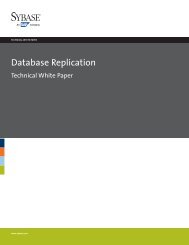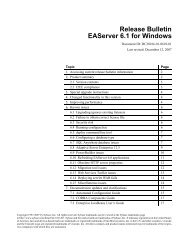A Practical Hardware Sizing Guide for Sybase IQ
A Practical Hardware Sizing Guide for Sybase IQ
A Practical Hardware Sizing Guide for Sybase IQ
Create successful ePaper yourself
Turn your PDF publications into a flip-book with our unique Google optimized e-Paper software.
alance the page size, concurrent users, and virtual storage (caches and dbspaces) <strong>for</strong> <strong>IQ</strong><br />
temporary store.<br />
As the page size increases so must the amount of RAM and disk space necessary to support the<br />
larger page size. As the concurrency increases, the impact of a larger page size will drive RAM<br />
and disk space to be increased to handle the increased users.<br />
Table Row Count<br />
Though the manuals reference ultimate database size as a factor <strong>for</strong> the page size, the current<br />
practice is to look at this as a last resort when no other in<strong>for</strong>mation is available to determine an<br />
optimal page size. The best data related factor <strong>for</strong> determining page size is the total number of<br />
rows expected in the largest table.<br />
To paraphrase chapter 5 "Choosing an <strong>IQ</strong> Page Size" of the <strong>Sybase</strong> <strong>IQ</strong> System Administration<br />
<strong>Guide</strong> these are the recommendations <strong>for</strong> setting the <strong>IQ</strong> page size:<br />
� 64KB -- For databases whose largest table contains up to 1 billion rows. This is the<br />
absolute minimum <strong>for</strong> a new database. On 32-bit plat<strong>for</strong>ms, a 64KB <strong>IQ</strong> page size gives<br />
the best per<strong>for</strong>mance.<br />
� 128KB -- For databases on a 64-bit plat<strong>for</strong>m whose largest table contains more than 1<br />
billion rows and fewer than 4 billion rows. 128KB is the default <strong>IQ</strong> page size. This is<br />
generally acceptable <strong>for</strong> most environments.<br />
� 256KB -- For databases on a 64-bit plat<strong>for</strong>m whose largest table contains more than 4<br />
billion rows.<br />
� 512KB -- For databases on a 64-bit plat<strong>for</strong>m whose largest table contains more than 10<br />
billion rows.<br />
Experience in recent implementations of <strong>Sybase</strong> <strong>IQ</strong> reflects the following:<br />
� 64KB -- Hasn't been used <strong>for</strong> systems other than 32-bit Windows<br />
� 128KB (<strong>IQ</strong> default) -- A majority of implementations have used this default page size.<br />
These systems generally have tables with fewer than 2-3 billion rows.<br />
� 256KB -- Systems that have used this page size have had tables in the 4-8 billion row<br />
range<br />
� 512KB -- The larger systems with tens of billions of rows in tables have used this page<br />
size<br />
Using row counts alone should not be the only indicator of what <strong>IQ</strong> page size is appropriate. The<br />
general consensus and use pattern is that as the amount of RAM on the system is increased, the<br />
page size can also be increased.<br />
Operational Impact<br />
There are many downstream effects of increasing the <strong>IQ</strong> page size that must be considered,<br />
including space consumption, memory use, and versioning.<br />
Space consumption <strong>for</strong> objects may not be an issue <strong>for</strong> those in main store as they are generally<br />
larger and will fill pages regardless of size. Small lookup and reference tables (less than a few<br />
thousand rows, generally), however, may see an increase in size with an increased page size. A<br />
smaller page may be 50% full with data while a larger page may be only 33% or even 25% full<br />
with the same data; the data didn't change, just the storage "bucket" that the data is held in.<br />
While <strong>IQ</strong> applies compression algorithms prior to storing the data on disk, this may still be a<br />
concern. The final data at rest on disk will be done in blocks. A block, by default, is 1/16th the<br />
Final<br />
35
















